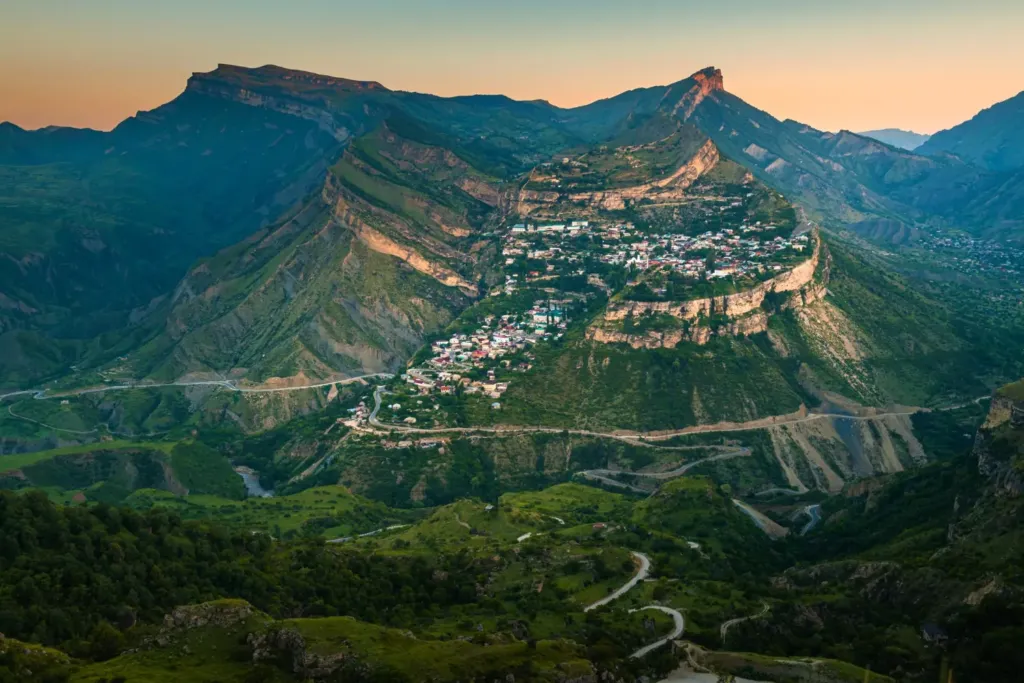Dagestan is a republic in southern Russia, located on the eastern slopes of the Greater Caucasus and on the Caspian lowland. It covers about 50 300 km² and has approximately 3 million residents. The administrative center and largest city is Makhachkala. Dagestan borders Azerbaijan and Georgia and is washed by the Caspian Sea. Russian is the lingua franca; more than forty ethnic languages are also spoken.
History
The territory of modern Dagestan was inhabited since the Neolithic by Iranian-speaking tribes, later by Scythians, Sarmatians and Alans. Islam arrived in the 7th century, shaping the region’s culture. In the 18th–19th centuries, Dagestan was a battleground during the Caucasian War between Imperial Russia and local khanates. In 1921 it became part of the USSR. After the Soviet collapse it experienced ethnic clashes and an Islamist insurgency in the 1990s–2000s. Today Dagestan is a stable republic within the Russian Federation.
Statistics and Industry
Dagestan’s GDP is about USD 15 billion, GDP per capita around USD 5 000. Official unemployment is 11–15 %. Key industries: oil and gas extraction and refining, chemical production, food processing, woodworking. Light industry, building materials and handicrafts also play a significant role.
Religion
Approximately 93 % of the population are Sunni Muslims, 3 % belong to the Russian Orthodox Church, up to 1 % are Catholics and Protestants, and around 3 % follow other religions or are non-religious. Islam in Dagestan is interwoven with ancient mountain traditions.
Clothing
In urban areas people wear European-style business and casual clothes—trousers, shirts, jackets, modest dresses. Women should avoid very short skirts and deep necklines. In remote mountain villages it’s respectful to dress more conservatively—covering shoulders and knees. For hiking, waterproof jackets, layered clothes and sturdy boots are essential. On Caspian beaches, swimwear is appropriate only at swimming facilities.
Living Standard and Corruption
Dagestan’s living standard is below the Russian average: average wages about RUB 35 000. By HDI it ranks low among Russian regions. Russia stands 136th out of 180 on the CPI; corruption is higher than average, especially at local bureaucracy and by traffic police.
Wars and Conflicts
Since its foundation there have been no major wars on Dagestan’s territory. It gained stability after the 1990s insurgency; small-scale extremist incidents still occur, but the situation has improved greatly since the mid-2000s.
Tourism
Dagestan combines mountains, coast and ancient cities. Visitors can experience several climatic zones in one trip—subtropical Caspian shore to snow-capped peaks. The region offers historical tours, eco-adventures, beach holidays, gastronomy and ethnographic routes.
Tourist Attractions
– Derbent: Naryn-Kala fortress, old town, Friday Mosque
– Makhachkala: embankment, regional historical museum
– Sulak Canyon: panoramic viewpoints, river rafting
– Chirkei Reservoir and waterfalls
– Gunib: famed mountain stronghold, panoramic views
– Khunzakh waterfalls and plateau
– Kubachi village known for metalwork
– Andi plateau and rock petroglyphs
– Malgobek limestone massif and caves
Non-Tourist Attractions
– Botlikh ridge: remote auls with traditional way of life
– Lipovaya Roscha nature reserve near Agvali
– Fish markets and Caspian seafood eateries
– Gotsatl and remote fishing hamlets
– Family-run ethnographic museums in Tabasaran areas
Why Visit
Dagestan’s ethnic and landscape diversity is unrivalled. Off the beaten track, with affordable prices and genuine hospitality, it offers a profound cultural and natural experience.
Safety, Terrorist Threat and Wildlife
Major cities and main routes are generally safe; remote mountain areas require caution. Terror threat is moderate—enhanced security checks and checkpoints are common. In the mountains, chamois, deer and wild boar may appear; they are not aggressive but should not be fed.
Service Level and Hotels
In Makhachkala and Derbent there are 3–4-star hotels, guesthouses and apartments. Service is adequate, clean and friendly, though below Western European standards. In mountain areas, lodging is simpler and more authentic.
Types of Tourism
Cultural-historical tours, ethnographic journeys, eco-tourism and trekking, skiing on small local slopes, rafting, cycling, gastronomic routes, beach and water sports on the Caspian, photo tours.
Entry Rules (Visas)
Dagestan is part of Russia; visa rules follow Russian regulations. Most nationalities require a Russian visa. Citizens of CIS countries and visa-free states can stay up to 90 days. Required: a passport valid six months beyond departure and travel insurance.
Transport, Car Rental and Road Rules
Intercity buses and marshrutkas connect towns. Rail runs along the Caspian shore. Makhachkala airport offers domestic flights. Car hire is available in Makhachkala and Derbent with a driver’s license and deposit. Roads are often narrow and in poor condition in the mountains. Minor bribes to traffic police occur. No toll federal roads.
Drinking and Driving, Speed Limits and Cameras
The legal blood alcohol limit is 0.3 ‰. Exceeding it leads to hefty fines or license suspension. Speed limits: 60 km/h in towns, 90 km/h outside, 110 km/h on federal roads. Speed cameras are present on main arteries; dashcams are advisable.
Noise Regulations
Quiet hours from 22:00 to 7:00 and all day Sundays. Construction and loud music are prohibited during these times.
Daily Budget
Budget — RUB 2 000–3 000 (≈USD 25–35) per day: guesthouse, street food, public transport. Mid-range — RUB 4 000–6 000 (≈USD 50–75): hotel 3–4 stars, cafés, guided tours. Comfort — from RUB 8 000 (≈USD 100): private transport, higher-end lodging and services.
What Not to Do
Do not wild-camp outside designated areas, pick protected plants, swim in unmonitored rivers, photograph military sites or checkpoints, drink alcohol publicly near mosques, litter, or violate local customs, especially during religious holidays.
Climate and Best Time to Visit
Dagestan’s lowlands have a dry continental climate, mountains — alpine. Summers are hot (25–35 °C) on the coast and mild (15–25 °C) in the mountains. Winters can drop to –10 °C inland. Best for trekking and sightseeing: May–June and September–October. For beach holidays: July–August. For skiing: December–March.
- Sydney
- Arabat Spit
- Kenya Nchi Yangu
- Facts and tips about sharks
- Baikal facts
- Moscow
- Pakistan
- Haiti, unfiltered: how to travel smart and fall in love with the country
- Barbados
- Rising prices for travel in Germany in 2025: reasons, scale and consequences
- Decline in international tourism to the US: causes and consequences
- Luo
- Ratmanov Island
- Bars Around the World Where Celebrities Left Their Mark
- Tourism crime in Amsterdam: how to avoid becoming a victim
- Chile
- Falkland Islands
- Finland
- Saami
- Namaqualand Flower Route












